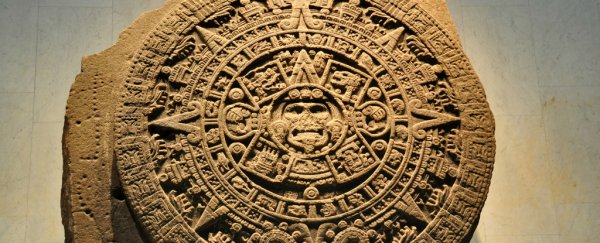When Spanish forces arrived in Mexico in 1519, the native population was estimated to be around 25 million. A century later, there were only around 1 million left, following several devastating outbreaks of disease brought in from overseas.
Despite plenty of speculation, the diseases that contributed to the collapse of Aztec society remain unconfirmed. But now scientists have presented the first DNA evidence of a bacterial species from one of the worst epidemics - and it suggests that a deadly outbreak of salmonella might have been involved.
The downfall of Aztec society has been the source of plenty of fascination, and it's generally believed that a variety of factors were involved - mainly the arrival of Spanish forces, followed by several outbreaks of European diseases among the native population.
The worst of those outbreaks were known as cocoliztli, from the word "pestilence" in the Aztec language Nahuatl.
It's during one of these cocoliztli, between 1545 and 1550, that up to 80 percent of the native population is believed to have perished.
"The 1545 cocoliztli epidemic is regarded as one of the most devastating epidemics in New World history," a team of researchers led by the Max Planck Institute for the Science of Human History in Germany write in a paper published on pre-print site bioRxiv.
Researchers have previously suggested that measles, smallpox, or typhus could have been to blame for the outbreak. And a paper published in 2002 suggested that some kind of viral haemorrhagic fever, combined with drought, was behind the deaths.
But there's never been any solid, DNA evidence to confirm these hypotheses.
Now, the Max Planck researchers have presented evidence that the cause of the outbreak could have actually been a primitive and deadly form of salmonella.
In an attempt to figure out the cause of the Aztec epidemics, the researchers looked to a burial ground in the Oaxacan highlands of southern Mexico, where they extracted and sequenced DNA from the teeth of 29 people buried there - 24 of them were linked to the devastating 1545-1550 epidemic.
The team separated bacterial DNA from the DNA of the humans, and after comparing the results with more than 2,700 modern bacterial genomes, they found that several of the people they'd tested appeared to have been infected with a deadly strain of Salmonella enterica called Salmonella Paratyphi C.
Today, Paratyhi C is an extremely rare strain of salmonella, but it still appears, particularly in the developing world. The infection is spread through faecal matter and causes enteric fever - a typhus-like illness. Without medication, it kills 10 to 15 percent of people infected.
"We propose that S. Paratyphi C contributed to the population decline during the 1545 cocoliztli outbreak in Mexico," the researchers conclude.
This is potentially the first genetic evidence of the pathogen that took down the Aztec population after European colonisation.
"It's a super-cool study," Hannes Schroeder, an ancient DNA researcher at the Natural History Museum of Denmark, who wasn't involved in the research, told Ewen Callaway from Nature. "They make a really good case."
But before we get too carried away, we need to keep in mind that, so far, this research hasn't been peer-reviewed - the results have been put up on pre-print server bioRxiv for now so that others in the field to get stuck into them and test them further.
It's also already been noted by some experts that the study technique wouldn't have been able to pick up the DNA of any viruses that might have been involved in the cocoliztli, so we could be missing some big pieces of the puzzle here.
But the researchers told Nature that they couldn't comment on the research, as they've already submitted the results to a peer-reviewed journal, so it's likely that further confirmation of the discovery won't be far off.
And providing further evidence to their hypothesis is another, unrelated study published in bioRxiv last week, which found evidence of Salmonella Paratyphi C in Europe around 300 years before it would have caused devastation in Mexico.
That research was led by Mark Achtman from the University of Warwick in Coventry in the UK, and involved the analysis of a bacterial genome taken from a young woman buried in Norway in the year 1200.
It's the earliest known genetic evidence for the Paratyphi C strain of salmonella, and is a solid indication that the strain was circulating in Europe before European settlers arrived in Mexico.
That on its own isn't enough to link the two discoveries together, but it's a good starting point, Hendrik Poinar from McMaster University in Canada told Nature.
"Really, what we'd like to do is look at both strains together," he explained.
Researchers will now need to find more ancient genomes from both Europe and the Americas during this time if we want to get a better idea of what caused the deadly epidemics that wiped out Aztec society.
But it's an interesting place to start.
"The idea that some of them might have been caused by Salmonella is now a distinct possibility," Shroeder told Callaway.
You can read the full paper on the discovery of Salmonella Paratyphi C in Mexican burial grounds here, and the paper showing Paratyphi C was present in Europe in the 1200s here.
